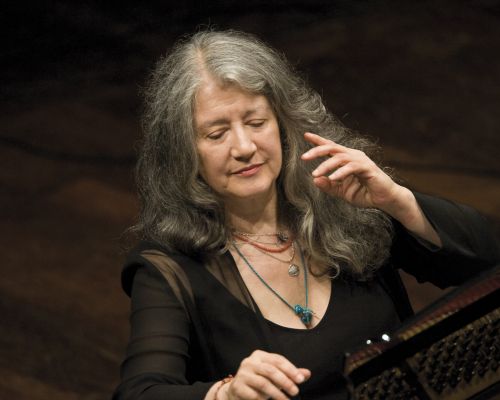 United Kingdom Bach, Schumann, and Beethoven: Anna-Liisa Bezrodny, Charlotte Scott (violins), Martha Argerich (piano), Oxford Philharmonic Orchestra / Marios Papadopoulos (conductor). Town Hall, Oxford, 14.1.2019. (CR)
United Kingdom Bach, Schumann, and Beethoven: Anna-Liisa Bezrodny, Charlotte Scott (violins), Martha Argerich (piano), Oxford Philharmonic Orchestra / Marios Papadopoulos (conductor). Town Hall, Oxford, 14.1.2019. (CR)

Bach – Concerto for Two Violins in D minor, BWV 1043
Schumann – Piano Concerto in A minor, Op.54
Beethoven – Symphony No.3 in E-flat major, Op.55, ‘Eroica’
Currently celebrating its 20th anniversary this season, the Oxford Philharmonic Orchestra repeated this concert which was first given, away from home, in London (review click here). Bach’s Double Concerto may have been an unusual curtain-raiser in the context of the rest of the programme, but the three principal eras in musical history were thereby checked off – Baroque, Classical (just about, in respect to Beethoven’s Symphony No.3) and Romantic.
The Oxford Philharmonic stood during their performance of the Bach, and despite the generous number of string players (using modern instruments), the antiphonal placing of the violins ensured a boisterous vigour as the orchestral dialogue was bandied back and forth. That bustle might have told more if it had been reserved for the finale alone, where the emphatic, Vivaldian fury towards the conclusion was dramatic, whereas a lighter touch in the opening movement would have provided due contrast. In both instances the determined course of the music was bolstered by the firmly projected continuo line from the cellos more than the discreet accompaniment on harpsichord by the orchestra’s conductor, Marios Papadopoulos. The two violin solos from Anna-Liisa Bezrodny and Charlotte Scott tended to be strenuous and mannered, sometimes impelling the currents of the score naturally, but they missed the autumnal, golden hue of the Largo second movement, even if they drew the melodic lines more lyrically.
The structural rise and fall of tension in the performance of Schumann’s Piano Concerto was more palpable, the Brahmsian, stormy passion of the first movement perhaps rightly held in check as an impotent, frustrated gambit that found more fiery purpose and eventual triumph in the finale. The vociferous attack upon the Concerto by Papadopoulos and the Oxford Philharmonic at the start rather ignored Schumann’s qualification affettuoso to the movement’s Allegro marking. But with her often starkly etched melodic line on the piano, Martha Argerich was inclined to follow suit, and so underlined the unsettled and impetuous aspects of this work. In the Intermezzo second movement, Argerich was more matter of fact, as though trying to pull the orchestra back from its reveries with her cooler and more objective approach in the passages which alternated with the Oxford Philharmonic’s softly-breathed musings. However, it was the little woodwind fanfares which heralded the finale with more alacrity than Argerich, although her crisp and confident way with the principal theme of the latter movement urged it forwards to the decisive conclusion. As encores she offered a foursquare interpretation of ‘About foreign lands and peoples’, the opening section of Schumann’s Scenes from Childhood, and then despatched ‘Dream’s Confusion’, the seventh of the same composer’s Fantasiestücke, Op.12, with flickering sprightliness.
Papadopoulos’s account of Beethoven’s ‘Eroica’ Symphony was urgent and hefty with, at times, a nervous, edgy disposition in its desire to push on from one section to the next, even if the tempos chosen were not actually hurried. Omitting the repeat of the first movement’s exposition certainly contrived to give that impression, and the cumulative weight of integrated sound was impressive. But some aspects of that orchestral texture stood out rather too rashly, such as some raw interjections from the violins, and blaring horns which disturbed the overall balance – had this been a historically informed performance there might have been some justification for the assertion of such brash colours, but it was not and so these elements were misjudged.
The Oxford Philharmonic played the Scherzo with some raucous, chattering abandon, though the horns disported themselves more decorously in the Trio section, and it offered some relief after the fairly relentless way with the Funeral March second movement. As in the first movement, a certain stern or indefatigable manner can, and indeed should, be brought off in these parts of the Symphony. But they should also delineate a more dynamic, rhetorical argument than the merely stubborn course pursued here which resulted in making less out of the music rather than more. The finale was a somewhat amorphous and routine trek through the variations on the ‘Eroica’ theme which Beethoven had already used in a set composed for piano, extracted from his ballet, Prometheus. Its import for Beethoven – and for music history, in the context of this ground-breaking Symphony – needed explicating with more variety and deliberation, not least in the slower, penultimate passage which really needed to draw apart from the preceding maelstrom and reflect for a moment before the headlong rush at the end. Undoubtedly this performance was thrilling at times, but lacking a nuanced overall vision, it amounted to less than the sum of its considerable parts.
Curtis Rogers
